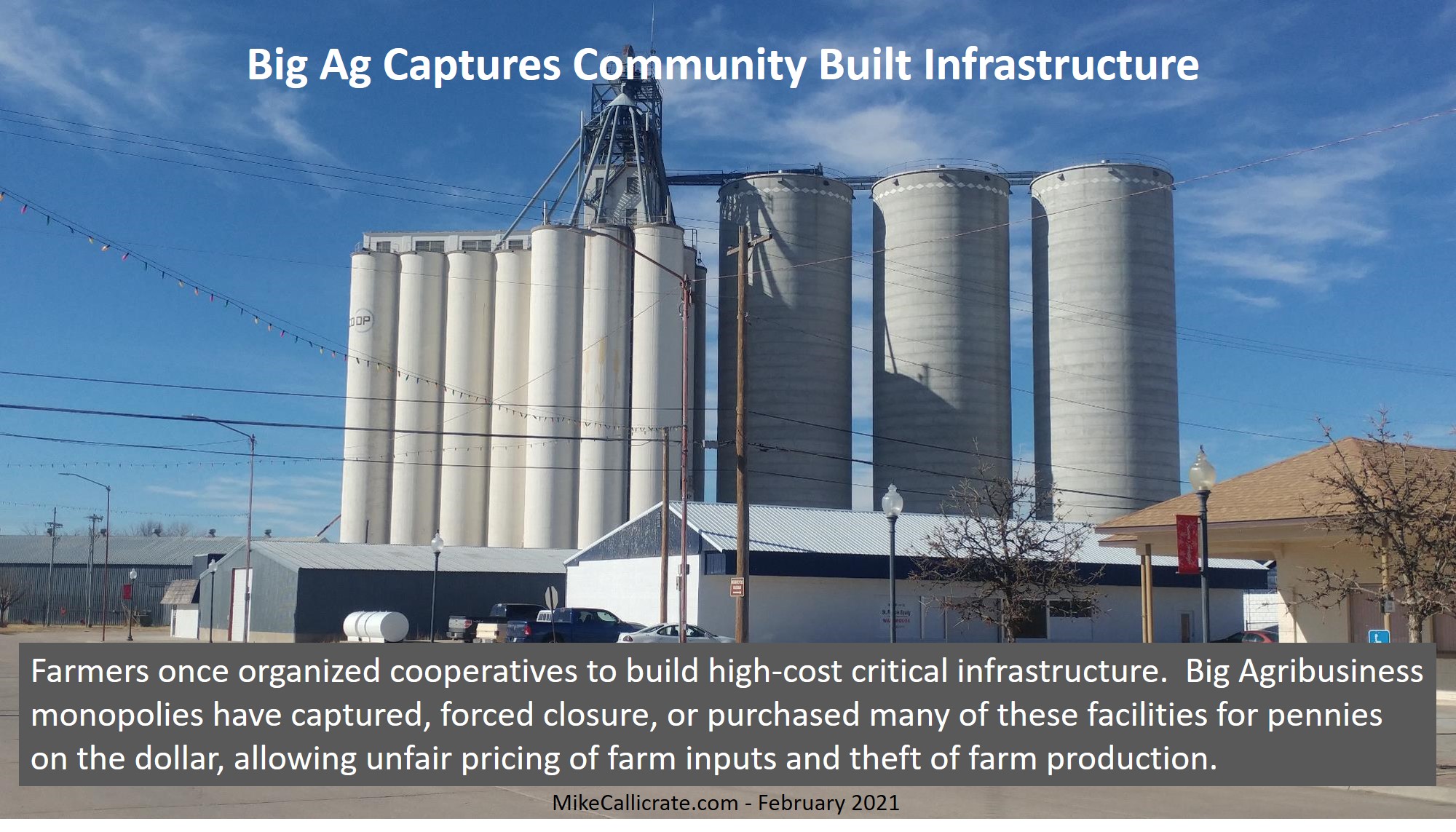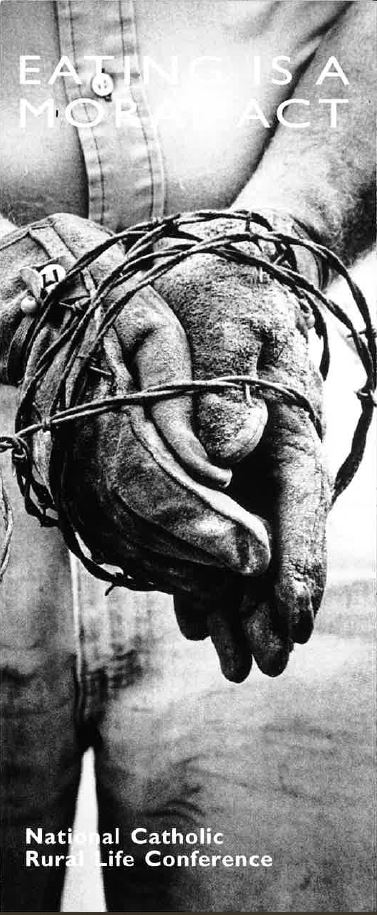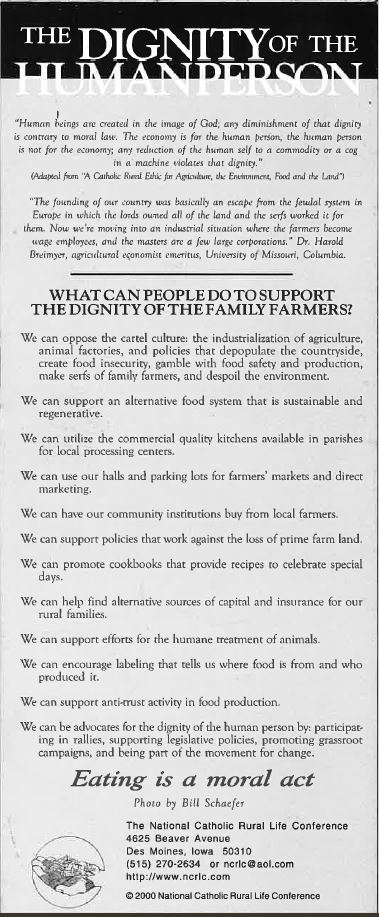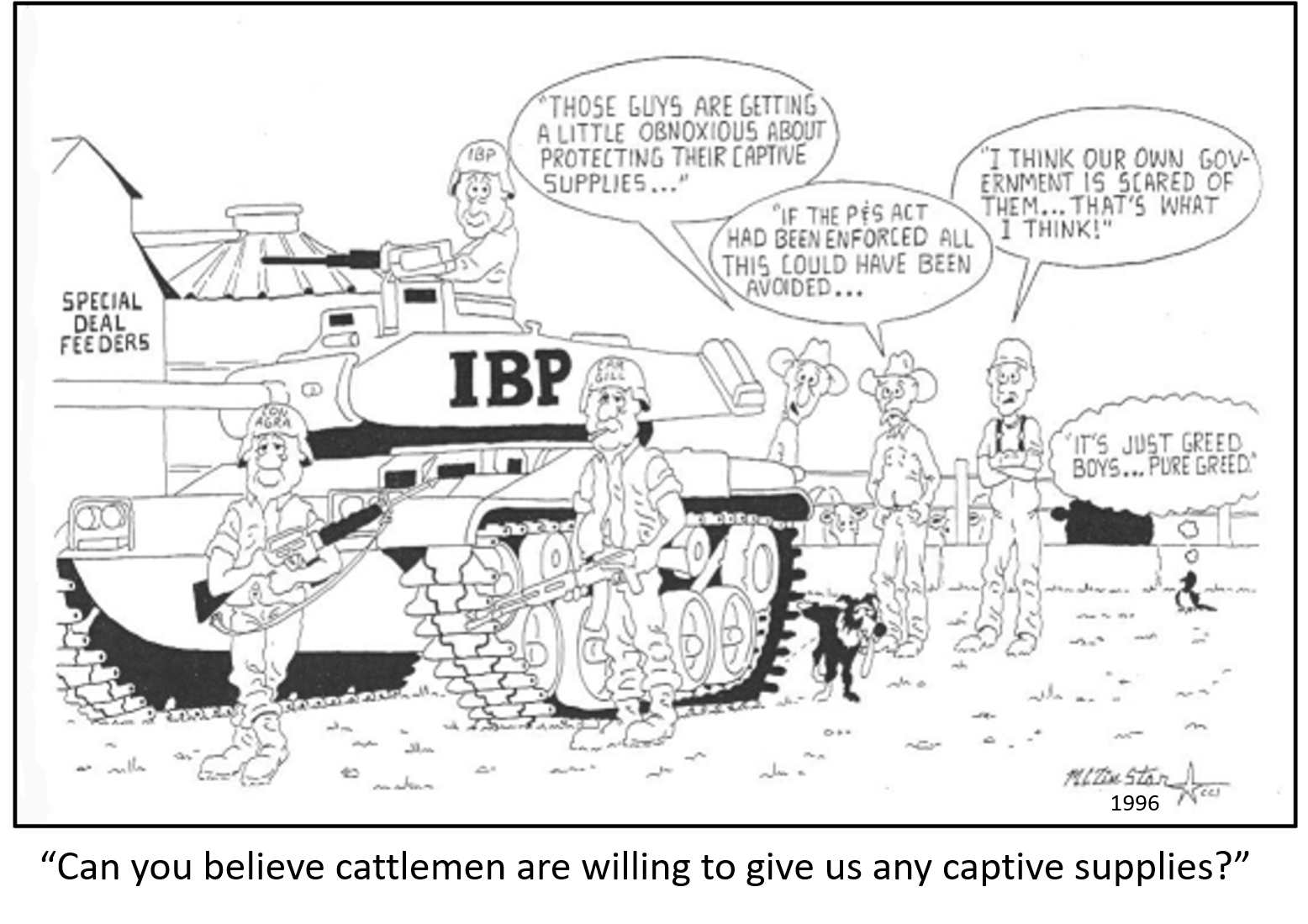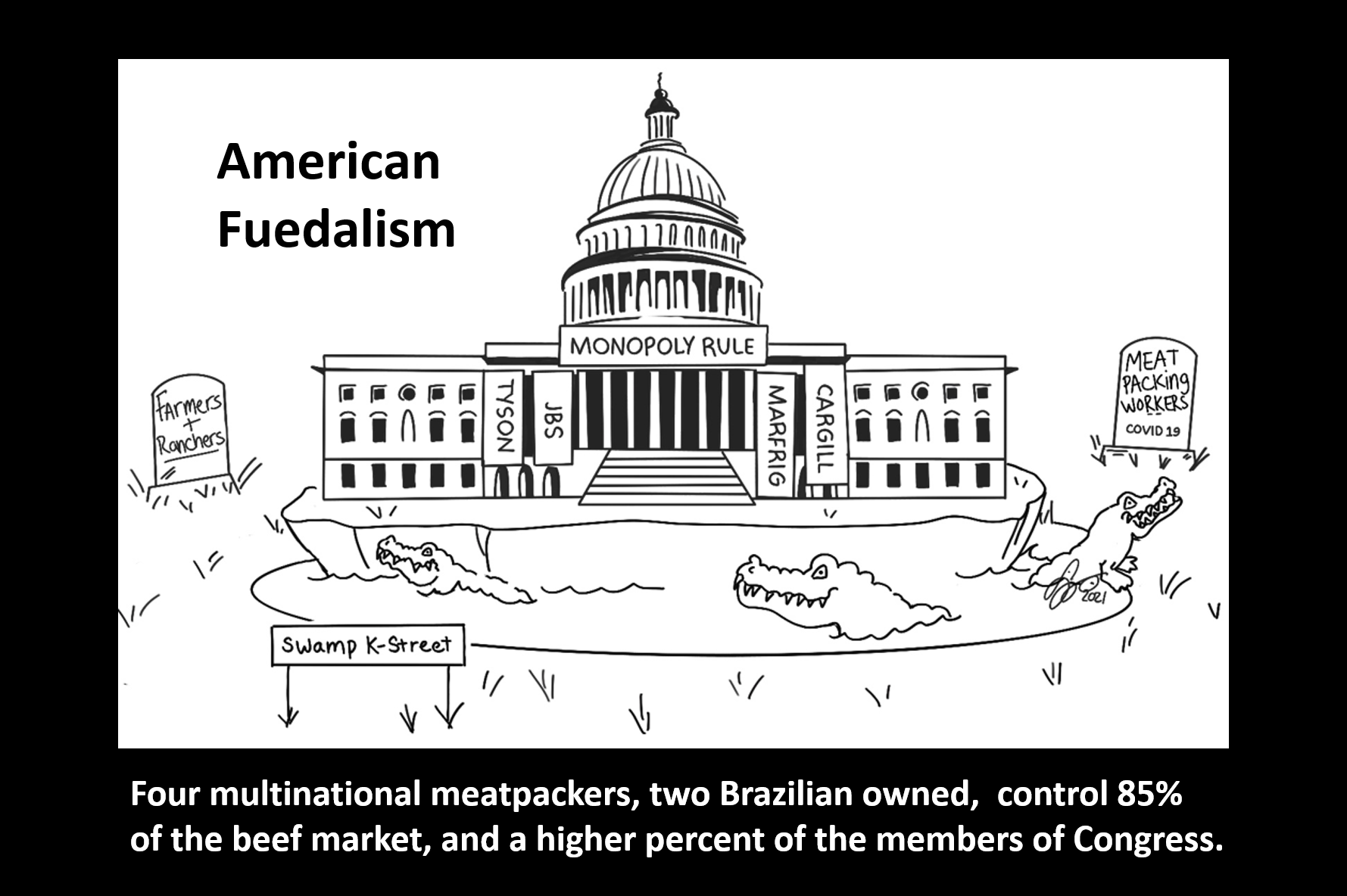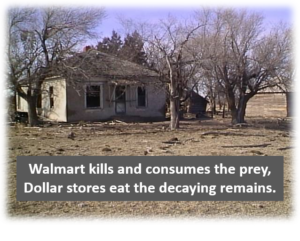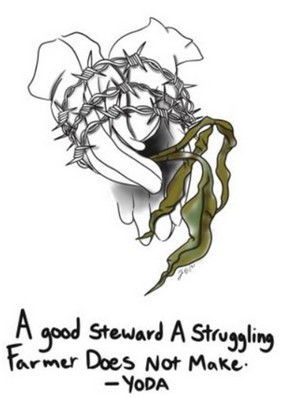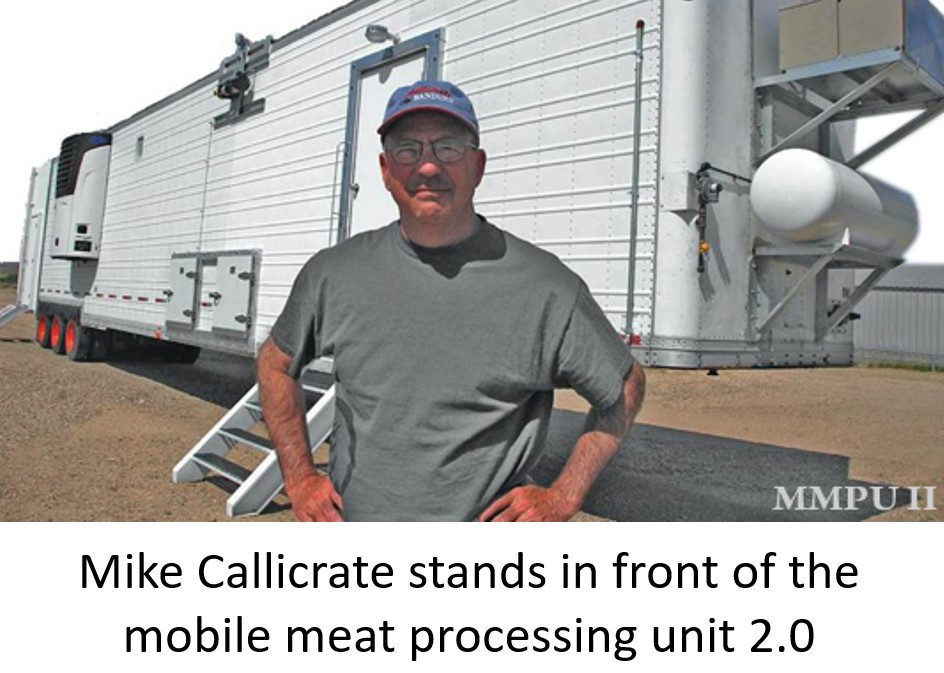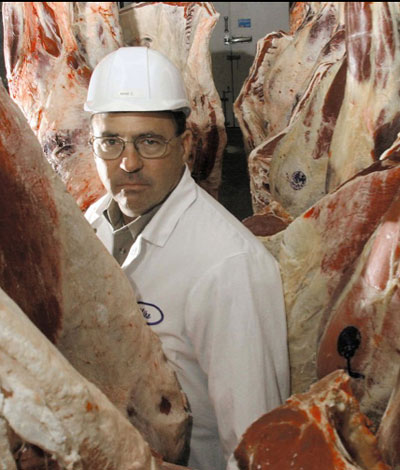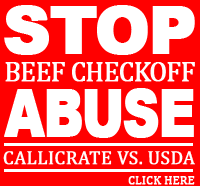We have almost accomplished in 245 years what took the Romans nearly 1,000 years – losing a republic.

St. Paul’s Husbandman quote is cut in stone above the entrance to the USDA building in Washington DC. Few people inside the historic building have read it or even know what it means.
Like our farmers and ranchers, Saint Paul’s Husbandman quote, inscribed above the entrance to the USDA headquarters in Washington DC has become weathered, faint, and unimportant. Construction of the original USDA building began in 1862, with occupancy in 1868 under the presidency of Abraham Lincoln and the first Agriculture Commissioner, Issac Newton. The Jamie L. Whitten building, where the St. Paul quote is displayed, opened in 1908 as the Robber Barons were monopolizing our food system.
Why would President Lincoln and Ag Commissioner Newton feel honored with the quote being cut indelibly into stone in the most visible place on the building? The answer lies in the first report of the Commissioner of Agriculture who saw agriculture as, “… the most ancient, the most honorable, and the most indispensable of all the occupations of man.”
The reader will see in Commissioner Newton’s following report, detailing the history of events leading to the downfall of the Roman Empire – mistakes we are now clearly making in regards to agriculture and the concentration of power and wealth.
The secret to a healthy planet, healthy people, and prosperous communities, although less visible now with age, still remains in plain sight for all to see at 1400 Independence Avenue.
REPORT OF THE COMMISSIONER OF AGRICULTURE FOR THE YEAR 1862
DEPARTMENT OF AGRICULTURE,
Washington, January 1, 1863.
IN compliance with the foregoing law organizing the Department of Agriculture, I have the honor to submit my first annual report. In so doing, I have deemed it not inappropriate to offer some observations on the magnitude of the interests intimately connected with, or growing out of agriculture, the most ancient, the most honorable, and the most indispensable of all the occupations of man, and to give a rapid glance at the improvements which successive ages have wrought in this department of knowledge, and the progress made in our country in later years, as well as the special operations of this department since its organization.
Agriculture in its first inception could scarcely be considered as an art, or even occupation. The ancients, deriving their food chiefly from the spontaneous productions of the soil, styled the earth their mother; but we, in the light of a higher philosophy, are reminded by our own harvest home and finished year, of our obligations to one common Father, who gives “rain from heaven and fruitful seasons, filling our hearts with food and gladness.” Health has everywhere prevailed; and notwithstanding the temporary transfer of large numbers of our patriotic countrymen from their farms to the ranks of the army and navy, yet the great interests of agriculture in the loyal States have not materially suffered. Abundant crops of the cereals and other grains, of grasses, of roots and fruits, have been garnered. Besides feeding the settled and increasing population of the country and our immense land and naval forces, we have exceeded the exportation of any previous year by over 17,000,000 of bushels of grain.
Agriculture, whether viewed as an art or science, presents a history as marked and important as that of any other great civilizer in the world’s progress. In its rudest state men subsist, for the most part, upon the chase, or such roots, fruits, and grains as are easily gathered. In its second stage men follow the pastoral life, wherein as nomadic tribes, inhabiting hilly countries or table-lands, they depend chiefly upon flocks and herds for food, raiment, and locomotion. In Central Asia—that mysterious source of languages, religions, and races—this condition of agriculture has ever prevailed. Next, increase of population, demand for food, richness of soil, and the spirit of adventure, have forced or attracted men to the now celebrated alluvial plains of the world. Finally, from the great centres of modern population the same migrations of races are taking place as of old; planting new empires in the wilderness, and making a superior agriculture—whether in hilly countries, table-lands, or alluvial plains—the great and essential art of life.
“A few proprietors held the land and owned the labor. The poverty of the many, with its evils of want, of ignorance, and dependence, existed by the side of the excessive wealth and culture of the few.”
As history is philosophy teaching by example, it would be highly instructive to discuss the condition of influence of agriculture as exhibited in the life of the two great nations of classical antiquity. For want of space, let us select for instruction the one which in magnitude, soils, wealth, power, energy, enterprize, and institutions resembled most our own republic. After a splendid career of prosperity, filling the world with her fame, Rome culminated and declined. No historical proposition is more susceptible of proof than that the great causes of that decline were the laws enacted affecting real estate and the condition, skill, and products of labor. For many years after Rome had grown to greatness, the cultivation of the soil was not only deemed honorable, but was regulated by law, in order that agriculture might yield the largest return to labor, and be, in reality, the great conservator of the empire. Not only were flocks and herds kept for food and raiment, and alluvial lands tilled, but the soils in more unfavorable regions were carefully and skilfully cultivated. At first the allotment of land to each citizen was but six acres. It was not ploughed, but spaded, and the yield was very great. Virgil, Cato, and Columella, Rome’s chief agricultural writers, invariably urge the cultivation of small farms, in order that the tillage may be thorough. The subdivision of estates, the limitation of their extent, and the habit of personal attention to farming, were excellent conditions for success. “The Romans,” says Frederick Von Schlegel, referring to the last days of the republic, “were a thoroughly agricultural people.” Changing this splendid basis of prosperity, permanency, and power, whereby, resting in the soil, Rome pierced the heavens by the force of thought, she grew proud and oppressive; the reins of power slipped from the hands of the middle classes; labor became disreputable; the soil a monopoly, and the masses of the people reckless, unpatriotic and degraded. A few proprietors held the land and owned the labor. The poverty of the many, with its evils of want, of ignorance, and dependence, existed by the side of the excessive wealth and culture of the few. The lands in Italy and in the conquered provinces were apportioned among the families of the great, instead of being given or sold as free homesteads to the poor. By this unequal distribution of property, and by forcing the husbandman into the army and buying up or taking his land, much of the soil was cultivated by servile labor. This monopoly of the land and condition of labor operated unfavorably to agriculture, and thus to the prosperity and permanency of the empire.
“This monopoly of the land and condition of labor operated unfavorably to agriculture, and thus to the prosperity and permanency of the empire.”
These two causes were destructive to intelligent, interested, and really productive agriculture. Certain staples, it is true, were raised in vast quantities; but these required little skill, and prevented the cultivation of a variety of crops. Old and exhausted lands were abandoned without any attempt to renew their fertility. The laborer felt no moneyed interest, no personal pride, in the result of his toil, and all generous progress in agriculture was retarded. The voice of history proclaims, in the clearest manner, that free labor and ownership of the soil by the laborer, if possible, are necessary conditions to the highest success in agriculture and national prosperity. Give the laborer no interest, prospective or otherwise, in the soil he tills, and he cannot be otherwise than wasteful and inefficient.
“The voice of history proclaims, in the clearest manner, that free labor and ownership of the soil by the laborer, if possible, are necessary conditions to the highest success in agriculture and national prosperity.”
In the earlier days of the empire the maximum limitation of freeholds to 500 acres, in connexion with the old Roman love of agriculture, led to a careful and exact mode of culture. But in the later days of the empire, says Hallam, “the laboring husbandman, a menial slave of some wealthy senator, had not even the qualified interest in the soil which the tenure of villanage afforded to the peasant of feudal ages.” At this period, notwithstanding Rome’s matchless soil and climate, she was compelled to import food from her conquered provinces. Rome remained free while her middling classes retained a controlling influence; but when the tenure of the soil passed into the hands of the few, the incentives to industry, to order, and to a quiet life were gone. Her young men sought the excitement of the camp, the city, or foreign lands. Cut loose from the ties of home, and maddened by the bad example of the landed aristocracy, the poorer classes lost their old love of country and liberty. The mad prodigality which prevails in the confusion of a shipwreck may serve to explain the progress of luxury amid the misfortunes and terrors of a sinking nation. Some of the landed proprietors, at the period of which we speak, owned estates of such magnitude that, though tilled by slaves, the annual revenue of each amounted to nearly $3,000,000, which was squandered by the nobles in every excess of luxury. “Rivers,” says Seneca, “which had divided hostile nations flowed, during this period, through the vast estates of private citizens.” Read but the following graphic descriptions from the pen of Ammianus, the Roman, after the lands had been monopolized by the few, and agriculture degraded by servile labor, and say if here was not cause enough for Rome’s ruin and warning to America! “A secure and profound peace succeeded the tumults of the republic. Distant nations revered the name of the people and the majesty of the Roman senate. But this native splendor was degraded and sullied by the conduct of those who displayed the rent-rolls of their estates, and provoked the just resentment of every man who recollected that their poor and invincible ancestors were not distinguished one above another. Whenever these rich land owners visited public places they assumed a tone of loud and insolent command towards their equals, and appropriated to their own use the conveniences designed for the Roman people.”
“… after the lands had been monopolized by the few, and agriculture degraded by servile labor, and say if here was not cause enough for Rome’s ruin and warning to America!”
“Owing to the degradation of labor,” says Gibbon, “the plebeians disdained to work with their hands, and the husbandman, being obliged to abandon his farm during the term of his military service, soon lost his zest for work. The lands of Italy, which had been originally divided among the families of free and indigent proprietors, were insensibly purchased or usurped by the avarice of the nobles. In the age which preceded the fall of the republic it was computed that only 2,000 citizens were possessed of any independent subsistence. When the prodigal, thoughtless commons had imprudently alienated not only the use but the inheritance of power—to wit, their own homesteads and free life—they sank into a vile and wretched populace!”
Such is one of the great lessons of history; and any nation that desires permanent prosperity and power should learn it well, wisely protecting labor and capital, and encouraging the division and cultivation of the soil.
There has been no great and general advance in agriculture in modern times till within the last thirty years. In particular localities, it is true, there was earlier improvement. In the Low Countries roots were cultivated with success, and the Dutch became celebrated for the products of the dairy. In portions of France, Germany, and Spain, the vine was extensively cultivated. But a writer who had observed extensively himself, and had access to the best information, says, in 1828, that the agriculture of continental Europe at that time was not very different from that of Britain during the middle ages.
Great Britain is indebted in a large measure to Lord Bacon for her early attention to progressive agriculture. That great thinker gave to the world inductive philosophy, which teaches man to experiment, to question, and test nature by her great alphabet of soils, gases, elements, and phenomena—a philosophy which is at once positive, progressive, and eternal, making man the “minister and interpreter of nature.” It would be highly interesting and instructive to notice at length, were there space, the successive English writers on agriculture, themselves practical farmers, who accepted Bacon’s philosophy, from their first publications, early in the 17th century, down to our own day. A gradual but positive improvement appears in their works and in their noble calling. Increased attention was paid to rural pursuits and the other arts, science meanwhile developing the importance of agriculture and foreshadowing its ultimate triumph.
Early in the 18th century Jethro Tull, one of England’s earliest and best writers on agriculture, recorded and published his experiments in new modes of culture. Some of his theories were erroneous, but his experiments were invaluable. Farmers are indebted to him for the horse-hoe and for drill husbandry. He also invented, but failed to perfect, the threshing machine, which, by the improvements of our own countrymen in our day, is rendered a most effective auxiliary to the labor of man. Arthur Young, who wrote in the latter part of the 18th century, was another zealous contributor to agricultural progress. He wrote and edited nearly one hundred volumes on subjects more or less directly connected with farming. He traveled extensively, both in England and on the Continent, to observe the modes of culture which prevailed. He made numerous experiments on soils to ascertain the causes of fertility, and thus prepare the way for the more scientific researches of a later period.
Many writers in Scotland, among whom Lord Kames is conspicuous, aimed to awaken a deeper interest in agriculture; but to no one is the farmer more deeply indebted than to Sir John Sinclair. At his suggestion, and under his personal supervision, a statistical account of Scotland was undertaken, embracing a complete agricultural survey of that country. It was completed and published in forty volumes and forms a noble monument to his perseverance and energy of character. It was followed by most important results, for it led to the establishment of the board of agriculture by Mr. Pitt, in 1793. This association brought farmers together, promoted an interchange of thought, made them acquainted with each other’s mode of culture, and produced throughout the United Kingdom the stimulus which intelligent, associated effort always produces. More than all, the board was instrumental in employing Sir Humphrey Davy to make those experiments, which are not only an honor to intellect, but which established agricultural chemistry as a department of science, and of inestimable value. He delivered his lectures on this subject in 1802. The fundamental principle which he developed, and demonstrated, was this: That the productions of the soil derive their component elements which, for the most part, are hydrogen, carbon, oxygen, and nitrogen, either from the atmosphere by which they are surrounded, or from the soil in which they grow. He showed that the process of vegetation depends upon the perpetual assimilation of various substances to the organs of the plants, in consequence of the exertion of their living powers and their chemical affinities, stimulated chiefly by moisture, light, and heat. The discoveries in chemical science before Davy’s time had, undoubtedly, prepared the way for his triumph, but he is none the less entitled to praise. He first recognized a plant as a living thing, the laws of whose existence were to be studied in order to develop a perfect growth. He showed, by analysis of soils and plants, what properties and conditions would best furnish the elements needed in cultivation. The success of Mr. Coke, afterwards Earl of Leicester, in the cultivation of his estate at Holkham, is a memorable instance of what scientific farming will do. When he succeeded to the estate, in 1776, large parts of it were so sterile that they were let on long leases at about seventy-five cents per acre per annum. Wheat was not grown upon it. One part of the soil was a “blowing sand” and the other a flinty gravel; yet on these strata, aided by the skill, the capital, and the enterprize of the proprietor, the estate became fertile—the pride of the country. In 1816 Mr. Coke estimated the yield of wheat alone at forty to forty-eight bushels per acre. Such were the men who wrought that marvellous change of which Macauley speaks. “At the close of the seventeenth century,” says the historian, “agriculture in Great Britain was in a rude and imperfect state. The arable and pasture lands were not supposed to amount to more than half the area of the kingdom. The remainder was believed to consist of moor, forest, and fen. In the course of little more than a century, a fourth part of England had been turned from a wild into a garden.” After the introduction of drill husbandry, the total value of agricultural products in the United Kingdom has more than doubled. Fifty years ago, even, there was much land in Great Britain in the condition of some lands in our older States at present—either left in their wild state or exhausted of fertility. This has been entirely changed. A hundred acres which, under the old system, produced annually, as food for cattle and manures, not more than forty tons, now produces 577 tons.
“Men value most what they have gained with effort, and a just confidence in their own powers results from success.”
Prior to the commencement of the present century, there was but little agricultural progress in the United States. The first settlers had many and great difficulties to encounter in clearing the land, in bringing it under cultivation, and in defending themselves against the Indians. Besides, the French and revolutionary wars very much interfered with the peaceful pursuits of agriculture. Nor could the people, after the peace of 1783, burdened with debt, without money to pay their taxes, with no manufactures, and no foreign demand for breadstuffs, be expected to make much progress in tilling the soil. Washington was unquestionably one of the most enlightened and successful farmers of his day. His correspondence with Sir John Sinclair, and his constant supervision of his estate, even during the stormy period of the revolution, and amidst the pressing cares and anxieties of the presidency, afford conclusive evidence that he was first in the arts of peace as he was “first in war and first in the hearts of his countrymen.”
But notwithstanding our early difficulties in planting an empire in the wilderness, our wars, our want of a market, our vast territory, sparse population, cheap land, and ruinous system of exhausting a virgin soil, yet great and manifold progress has been made in agriculture. The cast-iron plough, first patented in New Jersey in 1797, has undergone various modifications, until it has, reached a high degree of perfection. The spade, the hoe, the hay fork, and the other common implements, tools, and vehicles of husbandry, are lighter, of better material and temper, and more adapted to the use of the farmer. A large number of our farmers now use mowers for cutting their grasses, and the vast wheat fields of the west and northwest could not be harvested without the use of the reaper, nor the wheat separated from the straw, and the corn from the cob, without threshing and shelling machines. So great is the demand for farm labor, so great the spirit of enterprise which urges our young men and adopted citizens to become freeholders, and so sure, so near, and so vast the market, that without mechanical appliances, and the use of horse and steam power in the cultivation of the soil, our vast fields of grain could not be harvested and made ready for food and shipment. At present the United States are somewhat behind England in substituting steam for human muscle; but many years cannot elapse ere steam will be made by our enterprising farmers to plough and plant, to dig, haul, and grind, and to pump, saw, and thresh, and thus allow them to devote more attention to those branches of agriculture requiring special study, time, and taste. In all portions of our country, but particularly in the older States, a great improvement is noticed in tillage. Lands are being extensively under-drained, deep and subsoil ploughing practiced, and great care and considerable skill exercised in the preparation and application of manures. In the use of improved agricultural implements a great change has everywhere taken place. It is common to see the best plough, rollers, cultivators, reapers, threshers, fanners, hay and cotton presses, sugar mills, horse and steam powers, and a thousand other labor saving machines, the results of skill and science.
This imperfect sketch of agricultural improvement in England and the United States is given in order to show that progress has not been the result of mere routine farming, but of practically applied science—of classified knowledge. The great channels, for the most part, through which this knowledge has been widely and authoritatively diffused, are agricultural societies and publications. Wherever they have been established, either in England, on the Continent, or in America, the spirit of inquiry and emulation is awakened, prejudices are removed, and the results of a wide and varied experience, both of individuals and associations, in every branch of agriculture, are classified and published for the benefit of every farmer.
Notwithstanding the relation which the mass of farmers in England and on the Continent hold to the soil, enjoying neither ownership nor hope of wealth, yet these societies and publications have awakened a genuine, wide-spread enthusiasm and desire for further information. They have been the means of rousing American farmers, especially, to the importance of artificial manures, to the necessity of under-drainage, to the most successful modes of culture, and to the best farm implements and machinery. It is an auspicious indication of the progress made in agriculture in our country that already a thousand associations exist in the various States, and that most of our farmers read one or more agricultural papers.
But, however encouraging these noble aids to intelligent and successful farming may be, yet the surest evidence of our progress is furnished by the Preliminary Report of the Census Bureau for 1860. The facts there published have been carefully collected, and the comparisons or results which they afford are exceedingly important.
The total value of agricultural implements manufactured in the United States for 1860, not including, of course, those made on the farm, was $17,802,514 — being an advance of 160 per cent. on the amount manufactured in 1850. Among these implements are some of the highest importance to the farmer.
The threshing machine referred to before has been brought to a high degree of perfection, there having been issued, during the last fifty years, nearly three hundred patents for improvements. Being moved by horse or steam power, and furnished at a moderate cost, they are now in extensive use, greatly abridging the amount of manual labor, and enabling the wheat-growers to prepare their crops seasonably for the market.
In grain the census report gives the following results:
Wheat.—The quantity grown in 1859 was 171,183,381 bushels, being an advance, in ten years, of seventy per cent.; yet during the decade the ravages of the wheat midge in some of the older States have been very extensive. It is stated, however, that the midge is disappearing where, formerly, most destructive, and that wheat-growing will be resumed in many localities where, for a time, it was almost abandoned.
Indian corn.—The quantity grown in 1859 was 830,451,707 bushels, being an increase of over forty per cent. Drill planting, the horse-hoe, and improved corn-shellers, have greatly reduced the amount of manual labor necessary to the production of this crop, while the increased facilities for transportation to market have enhanced its value.
Dairy products.—The butter produced in 1859 was 460,509,854 pounds—an increase of forty-six per cent. The amount of cheese made, and the amount of milk and cream furnished to cities and towns, presents the same increase.
Cotton.—In the beginning of the present century the annual exportation was less than 5,000 bales; in 1859 production had increased to 5,198,077 bales. What is to be the future yield of this great staple time alone can reveal.
The value of animals slaughtered in 1859 was $212,871,653 — an increase of nearly 100 per cent. We have no tables to show the increase of imported stock. There is evidence, however, that various improved breeds of cattle and sheep have been largely introduced into the United States during the last decade, and that better cattle and sheep of finer wool and heavier fleeces are now becoming common throughout the country. Sheep we have imported from France and Germany, and while the quality of the wool has been maintained we have increased the quantity.
“… agriculture is the grand element of our progress in wealth, stability, and power.”
When the census of 1860 is published in full the inexorable logic of its statistics will astonish the world, and prove to every intelligent mind that agriculture is the grand element of our progress in wealth, stability, and power. All the new States, during the early periods of their settlement, have rapidly advanced in population and agricultural wealth. This has, of course, been owing chiefly to the rapid influx of residents from the older States and Europe, and to the fact that large tracts of land have been rapidly brought under cultivation. Let Minnesota, during the last decade, be selected as a specimen of progress.
In 1850 the number of acres of ploughed land was 1,900; in 1860, 433,267. In 1850 the number of bushels of wheat raised was 1,401; in 1860, 5,001,432. This rapid agricultural development in ten years is not only an encouraging agency of future progress, but a most remarkable fact of American history.
Various other facts, which cannot now be stated in detail, strengthen the conclusion that American agriculture, especially during the last ten years, has made great progress. Farms throughout the country are more thoroughly cleared of stumps and stones, fences are neater and more durable, farm-houses are more conveniently and tastefully built and adorned, barns are constructed with more reference to the comfort of stock, to the housing of produce, and to the preparation and preservation of manures. A more ready access to markets is afforded by good roads, railways, and canals, improved implements are in general use, while a salubrious climate, a prolific soil, a broad and quiet land, and a beneficent Providence have crowned with abundant success the labors of the husbandman.
Having reached this agricultural vantage ground by honest toil, guided by the lights of experience and science, it is an interesting question, to every American, What are the conditions of a still grander progress and prosperity?
The essential conditions, it seems to me, are—peace; a continued and increasing demand for agricultural products, both at home and abroad; an increased respect for labor; a more thorough knowledge and practice of agriculture as an art and science; and, finally, a more thorough education of our farmers in the physical sciences, in political economy, in taste, and general reading. Let us consider, briefly, these conditions. A state of war, whether civil or foreign, always reduces the productive industry of a country, and disturbs nearly all the great interests of society. Thus far, it is true, agriculture in the loyal States has been but little embarrassed by the march of armies and the devastations of battle; but this immunity cannot always be enjoyed should the war continue. We must return, therefore, to our normal condition, which is peace, if agriculture is to prosper.
With all its wide-spread evils, the rebellion offers, nevertheless, some compensations, and these will plainly appear should the government finally triumph. In order to preserve the unity of our soil and nation, a noble patriotism has withdrawn, for the time being, a large number of citizens from the peaceful employments of agriculture. Some sleeping on blood-stained fields of glory, or beneath the sea, will never more return to the farms which they have tilled; others will come home with broken health, while the many with strong frames will remain, or return to the regions where the storm of war has passed, to make them again blossom as the rose, and to rear new homes for themselves and their children.
The transfer of labor is one of the results of war in every age. In our own case the gain will be considerable, as free labor, smaller homesteads, a greater variety of products, and higher skill and energy in agriculture will take the place of the old system. There must be for a time, in many portions of our country, a scarcity of labor. Men enough, however, for the ordinary requirements of agriculture will be found in every community until labor flows in from Europe, equalizing, somewhat, the demand and supply. Besides, the increased value and labor, and the great demand for breadstuffs at home and abroad, will bring more extensively into use the drill, the horse-hoe, the mower, reaper, thresher, and other labor-saving machines, driven either by steam or horsepower.
“It is difficult to estimate the contribution which immigration, properly encouraged by legislation and administration, will make to the revenue, and therefore to the prosperity of the Union …”
If our present unhappy war soon terminates, and the knowledge of our homestead law and increased demand for labor is disseminated throughout Europe, the tide of emigration must speedily set toward America with increased power. Without any special stimulant there has been, hitherto, a steady and large increase in this class of our population. In the decade ending 1840 the number of passengers of foreign birth who arrived in this country was 552,000; in that ending 1850 the number was 2,707,624. The proportion of males to females for the three decades was as 60 to 39. Almost one-half of the whole number was between fifteen and thirty years of age. Of this total of 4,817,924 immigrants, 2,044,678 — nearly all the males — were classed in the official returns as farmers, laborers, and mechanics. I believe this vast influx of labor will continue as heretofore, stimulated by the character of our institutions, the fertility and cheapness of our lands, the demand and remuneration of labor, the increased facilities for immigration, and the noble homestead law, which at once goes into effect. “Every acre of our fertile soil,” says a great political economist, “is a mine which only waits the contact of labor to yield its treasures, and every acre is opened to that fruitful contact by the homestead act. When the opportunity, thus afforded to industry, shall be understood by the working millions of Europe, it cannot be doubted that great numbers will seek American homes in order to avail themselves of the great advantages tendered to their acceptance by American law. Every working man who comes betters the condition of the country as well as his own. He adds in many ways, seen and unseen, to its wealth, its intelligence, and its power.” It is difficult to estimate the contribution which immigration, properly encouraged by legislation and administration, will make to the revenue, and therefore to the prosperity of the Union, under the guarantee and inspiration of this magnificent law.
The second condition, on which depends our agricultural progress, is the continued and increased demand for our products, both at home and abroad. If our country increases in population in the ratio of the last decade, 100,000,000 of inhabitants will be under American law in the year 1900. Besides supplying this rapidly-growing population, Europe and portions of South America will continue to be our customers. Some of the great southern staples, it is true, are temporarily withheld from Europe; but, unless the war continues long enough to create new fields of culture elsewhere, the demand will continue as of old. The statistics of our commerce, even in a time of war, prove that corn is king, and that it can always be made, as it is now, the great conservator of peace between England and the United States. The parliamentary returns of Great Britain for the calendar year 1861 exhibit the following important fact in regard to the amount, in bushels, of breadstuffs imported for that year:
Wheat and flour, 86,552,097 bushels; of which the United States furnished 38,361,675 bushels, or forty-four per cent.
Indian corn, 20,360,004 bushels; of which the United States furnished 11,705,034 bushels, or fifty-seven per cent.
Total, 106,912,101 bushels, or forty-eight per cent.
The New York trade tables show that the United States exported to Great Britain and the continent, for the year ending September 1, 1861, wheat, flour, and Indian corn, 42,524,816 bushels; for the year ending September 1, 1862, wheat, flour, and Indian corn, 52,112,225 bushels. Finally, the report of the British board of trade, for the ten months ending October 31, 1862, shows that Great Britain received from the United States during that time produce amounting to $87,412,325, against $8l,728,035 in 1861. This vast amount has been imported while all the southern ports have been blockaded, showing that we furnish, even in a time of war, about one-half of all the food imported into Great Britain, and that the amount is steadily increasing.
“The third condition on which depends our agricultural progress is, increased respect for labor.”
The third condition on which depends our agricultural progress is, increased respect for labor. In many portions of the United States this condition is amply fulfilled, and the healthful results are plainly seen in finely cultivated farms, in improved homes, in education, thrift, and all the pursuits of an honest, intelligent, and respected industry.
The two prominent causes which have tended to degrade labor in the United States are, first, the many avenues to wealth, respectability, and position open to young men, independent of manual labor; and, secondly, the condition of a large portion of our laboring population. A great point will be gained for agricultural purposes when farmers shall cherish not only a high respect for their employment themselves, but instil their convictions into the minds of their children. It is not only a great mistake but a great misfortune that young men should feel dissatisfied with the comparatively slow gains of agriculture, or that they should regard the farmer’s life as one of tameness and drudgery. They notice the rapid growth of the property of the merchant, the trader, or the professional man, and see him in situations of apparent comfort and ease, limiting, however, their observations to the few who are successful, and not noticing the many who fail of ultimate success. Independent of the unrest, the disappointed ambition, the wear and tear, and mean rewards of public life, it is said that of one thousand merchants who had kept an account at one of the Boston banks, only six died rich. The number of successful merchants in New York is even less than this. On the other hand, the farmer, if not absolutely rich, is, at least, independent. He has a home which his labor and his taste have adorned; he has broad acres, not held by lease, as in many countries, but as a freehold. In the Old World land is generally divided into large estates, and owned by few proprietors. In England, for instance, the number of acres is 32,342,400; the number of proprietors about 44,000; in Scotland, 19,738,930 acres and 4,000 proprietors. Such is not the case in our country. No law of entail or primogeniture fosters the accumulation of large estates. It is one of the blessings of the American farmer that he owns in fee simple the land which he cultivates. He has not to stoop and cringe and stand in awe in the presence of those whom he calls masters. He has no master—no favors to beg of man. He has a sturdy independence of character, adorned, perhaps, by culture and refinement. He belongs to a class of citizens who hold in their hands five-sixths of the wealth of the country and its entire political power; and the hands which have wrought this wealth are able to defend the Constitution which makes us one people.
“He belongs to a class of citizens who hold in their hands five-sixths of the wealth of the country and its entire political power; and the hands which have wrought this wealth are able to defend the Constitution which makes us one people.”
In speaking of the other influence which tends to degrade labor in the United States I do not propose to discuss the vexed question of the relation between capital and labor, but to state a fact as patent as any other on the surface of American society. Slavery always and everywhere degrades labor. This degradation is positive at the south, while its reflex influence is felt throughout the north, in spite of the teaching of the press, the pulpit, the platform, and the example of millions of honest, noble, hard-working men. Had labor been respected at the south—had the soil, divided into moderate farms, been owned by those who tilled it, as at the west—no rebellion would have been desirable or possible. In Brazil the same influences are at work as in our own country. Servile labor has so degraded agricultural industry that a plough was unknown there thirty years ago, and an empire capable of feeding all Europe has never been able to raise food sufficient for its own 7,000,000 of inhabitants, but depends for its breadstuffs upon the United States and the neighboring republics. Though the greatest inducements have been held out by the government, immigrants, owing to the condition of labor, have hitherto been slow in settling in Brazil. Those who have gone, however, are forcing, by superior skill, intelligence, and public sentiment, slave labor towards the equator, and winning the victory which free labor ever gains.
Labor, for a fair remuneration, whether of the brain or hand, should be the glory of America; besides, there is true dignity in labor, especially in cultivating the soil. The object which the farmer has in view is to subdue the earth; to eradicate its briars and thorns, and to plant in their stead what is useful and beautiful to man. It is to fulfil the original appointment of the Creator, that man “shall eat bread in the sweat of his face.” “Labor,” says a noble worker, “has been made by Providence the law of man’s condition. It is the price at which whatever is valuable in life must be earned. Whatever, therefore, degrades labor as the business of life, or renders it distasteful or dishonorable, does violence to our social laws no less than to a wise economy.” All improvement—all progress of the race in civilization—has been the result of intelligent labor. It has built our cities, dug our canals, constructed our railways, developed our mines, built our steamers and ships, given life and energy to the industrial arts, and, above all, is feeding and clothing our people and providing for their happiness. “The nation,” says Dr. Sam. Johnson, “that can furnish food and raiment, those universal commodities, may have her ships welcomed at a thousand ports, or sit at home and receive the tribute of foreign countries, enjoy their arts, or treasure up their gold.” Let labor, therefore, be crowned with honor—that labor, especially, which contributes so much to the welfare of man, and allows him to approach nearest, through Nature, to Nature’s God.
The fourth condition on which depends our agricultural progress is a more thorough knowledge and practice of agriculture as a science and as an art; and by this is meant a knowledge of the principles—the whys and the wherefores—which lie at the foundation of successful farming, and of the practical application of those principles, combining skill, economy, and all the appliances of art. The great difficulty with the American farmer has been, and still is, that he has been nurtured and educated in the habit of cultivating a primitive soil. The labor and expense attending the accumulation and application of manures, with the necessity of unlearning old habits and theories, have made him tempt nature to the verge of exhaustion, and degrade a noble profession to one of mere routine. While Americans are ever disposed to boast of their inventive skill and teachable disposition, the elder nations, which we affect to despise, offer us some valuable lessons in agriculture. The Chinese, by minute and careful culture, by rotation of crops, and by the use of every possible kind of manure, have made their lands yield undiminished products for thousands of years. The northern provinces of China produce two annual crops, and towards the south five are usually obtained every two years. This prodigious yield has continued for ages, and yet the soil is rich and productive, teeming with nearly four hundred millions of human beings. The spade is extensively used; every inch of ground is thoroughly tilled; the hills are terraced, and the soil irrigated wherever possible. Agriculture is everywhere honored and encouraged. The Emperor himself goes annually to the field and turns the first vernal furrow. If China or Japan were to follow our methods of tillage, famine and death would soon sweep millions into their graves.
There is still in our country, strange to say, a large amount of what may be styled routine farming. The soil is tilled, the same seed sown, and the crops succeed each other year after year. In some cases, when the soil is inexhaustible, this may be the best method of farming for the present owners; besides, the example of father to son is invaluable, provided that example be good. Practical knowledge is certainly superior to mere theory; but to persist in the same succession of crops, in replanting the same and often the poorest seed, in pursuing the same methods of culture, in rearing the same common breeds of stock, in using the same poor implements of husbandry, is to deny the value of the aggregate experience of men of similar pursuits, and to ignore the progress of the age in science and the useful arts. It should be the aim of every young farmer to do not only as well as his father, but to do his best; “to make two blades of grass grow where but one grew before.”
“Agriculture,” says an ingenious writer, “is an art—man the artist. The soil is his laboratory; manures and seeds his raw material; animal strength and machinery his power; air, heat, and moisture his agents; and grain, roots, fruits, and forage his products. Agriculture is also a science, teaching the artist the best modes of improving and fitting up his laboratory; instructing him in the properties and economical use of his raw material; teaching him how best to apply his power and profit by his agents, thereby enabling him greatly to abridge his labors and multiply his products.” Art teaches the hand to do—science, what and how to do. Art belongs to the individual—science is the concentrated experience of ages and the labor of nations. It is, in short, classified knowledge illustrated in practice and confirmed by experience, and as certain and eternal as truth itself.
The great object of agriculture, as a result, is to develop from the soil as large a quantity and as excellent a quality of useful vegetable, or, indirectly, of animal, products as possible. In order to do this, the farmer should aim to preserve and increase the fertility of the soil; to free it from moisture when superfluous, or add to it when insufficient; to cultivate it thoroughly by the most approved methods, sowing the best seeds according to soils, climate, localities, and markets; to economize labor and expense by using the best implements and power; to select the finest breeds of animals, feeding and sheltering them in the most judicious manner; to secure most perfectly the several harvests, and prepare all farm products for the market in the best manner.
“It can be easily shown that there is no occupation of life where extensive knowledge is more necessary than in the proper cultivation of the soil.”
In order to make the farmer most successful, and thus to advance agriculture, the great interest of the republic, he should study chemistry as applied to soils, plants, grains, animals, manures, climates, localities, and tillage. This science, applied to agriculture, teaches him that of the sixty-four simple substances some thirteen go to form vegetation. It cannot be said that any one of these elements is more important, absolutely, than another, except that some of them are scarcer in some soils than in others, and more difficult to procure, and therefore, agriculturally, more valuable. Chemistry, by its powers of analysis, reveals the nature and composition of soils; teaches the proper kind, value, and application of manures; the mode and means of nutrition; and the knowledge of supplying wants and of correcting deficiencies and excesses, wherever noticed, in cultivation. Agriculture is a growth, like the plant it cultivates; and like the mind, also, the more it is developed the more it yields. It can be easily shown that there is no occupation of life where extensive knowledge is more necessary than in the proper cultivation of the soil. There is no occupation so intimately blended with all the branches of the natural sciences; to which geology, chemistry, botany, and entomology are such valuable auxiliaries. Of all human pursuits agriculture is first in order, in necessity, and importance. The best farmer is always the most intelligent man, and a community of knowledge is one of the strongest ties that can bind and bless society. The simple argument, therefore, is this: increased scientific and practical knowledge in any occupation increases man’s power in a tenfold ratio; agricultural knowledge, therefore, begets productiveness, and in the same proportion develops the wealth, the prosperity, and the progress of our country. Sir Humphrey Davy once remarked, when speaking of the future influence of agricultural chemistry, that “nothing is impossible to labor aided by science. The objects of the skilful agriculturist are like those of the thoughtful patriot. Men value most what they have gained with effort, and a just confidence in their own powers results from success. They love their country better, because they have seen it improved by their own talents and industry, and they identify with their own interests the existence of those institutions and pursuits which have afforded them security, independence, and the multiplied enjoyments of civilized life.” How strongly do these noble words from the father of agricultural chemistry appeal to the judgment and pride of every farmer to excel in his calling!
“Every farmer, therefore, should aim to be instructed, not only in his special calling, but to know something of general science, of political economy, of taste, and current and general reading.”
Another essential condition to agricultural progress, and following naturally the last named, is a more thorough education of the farmer in physical science, in political economy, in taste, and general reading. In fulfilling the condition of a thorough agricultural knowledge, the farmer will have advanced considerably towards an honorable education, and the greatest efficiency and success in his special calling. Still, there is a certain general culture which should characterize every intelligent citizen of a free country, fitting him to think and act wisely and well in all the relations of life. As our government, laws, institutions, and administration spring from the people, and as nine-tenths of our people are tillers of the soil, how important that, as a class, they should have broad and just views of whatever affects the common weal! Though far away from the great centres of political and commercial influence, yet they have the power to make all public servants respect and study their interests, which are eminently those of the whole country. Every farmer, therefore, should aim to be instructed, not only in his special calling, but to know something of general science, of political economy, of taste, and current and general reading.
“There are, really, but two great sources of national wealth—the soil and the mind of a nation.”
First, then, in regard to those sciences which are the handmaids of agriculture—what a field of study! These are meteorology and electricity, explaining atmospheric phenomena, upon the changes of which nearly all the operations of farming depend; hydraulics, suggesting plans for the recovery of swamps and submerged lands; botany and vegetable physiology, teaching the relations between natural plants and their soils, in order to establish artificial soils and the highest cultivation; exhibiting, also, the structure of the different orders of cultivated plants, and explaining their nature, and the use of the healthy, and the injurious effects of diseased secretions of plants; geology, explaining the formation of the earth’s crust in reference to drainage, and the effects of subsoils on the growth of trees and plants; mechanics, teaching the principles of machinery; anatomy and animal physiology, explaining the structure and functions of animal economy, with a view to perfect development and the prevention of disease; and many other cognate branches, a knowledge of which tends to make man the master of nature. The farmer should also be educated in political economy and those kindred studies which aim to make him a thoughtful and intelligent citizen. Being the vast majority in numbers and wealth, and sustaining the wheels of finance, of trade, manufactures, and commerce, the agriculturist has too much at stake to be behind any in education and influence. Finally, the farmer should breathe that general atmosphere of thought, which, coming to us from distant ages and across the sea, is fanned by pulpit, press, and printed book. Our fathers endured many hardships and privations; but the young farmer of to-day possesses a wealth of advantages for general culture enjoyed by no other people. In some portions of our country these advantages are being improved, and the yield of cultivated mind, like that of the earth, is, indeed, wonderful; but as there is no royal road to agriculture, neither is there to knowledge. The latter must be acquired by long mental husbandry, but, like that of the soil, it yields many solid pleasures during the period of hardest toil, while old age is full of health, wealth, ripeness, and joy, like the rich harvest of autumn. There are, really, but two great sources of national wealth—the soil and the mind of a nation. Where do we find the most prosperous individuals, communities, and nations? Where the mind and the soil are most cultivated. If, then, the cultivation of these adds wealth, power, and prosperity to a nation, the lack of either, where it might abound, is so much waste of national capital. Why is it, let me ask, that the annual earnings and products of Massachusetts—a State unfavored in soil and climate—exceed, per capita, not only those of every other State in our Union, but of the world? Why is it that the labor of a single man in Massachusetts is equal, in profit, as has been conclusively shown by the census, to the labor of five men in South Carolina? It is because her people believe, most thoroughly, that “knowledge is power,” and that it is the highest wisdom of political economy to invest largely in schools, colleges, books, a free press, and the highest culture of the individual, to the end that labor may be more productive because more skilled and better directed. But this culture of the mind in science, taste, and general reading, should be based on a higher consideration than that of mere moneyed profit. It should be sought for its own sake, and the pleasures which it brings. The farmer should have taste to appreciate and enjoy the beautiful in nature and in art; taste to adorn his home and his lawns with shrubbery, flowers, and works of art; taste to admire the ripening fruits, the glowing landscape, the processes of nature, and the living groups of animals which he has reared—more attractive to the eye than any painting, though drawn by the genius of Landseer.
“Men who have chosen to follow other avocations of life, and who pursue them with success, still long for the pleasures and employments of the farm.”
Let the farmer, therefore, as a cultivated man, magnify his occupation. In all ages wise, learned, and good men have gladly turned away from the employments of public life to the pleasures, the consolations, and the quietude of rural pursuits. Without citing the men of other countries and ages, who can forget how eagerly Washington laid aside his robes of office and sought the repose of Mount Vernon; how gladly Clay returned to the shades of Ashland after the excitement and honors of congressional life; and how Webster hastened from the cares of state to his herds and fields, and the sight and sounds of the ocean, all endeared to him by the sweet memories of rural life? Men who have chosen to follow other avocations of life, and who pursue them with success, still long for the pleasures and employments of the farm. All their plans of life have a kind of natural culmination in the determination to retire into the country and share with the farmer the healthful and dignified occupation of husbandry.
“… whatever improves the condition and the character of the farmer feeds the life-springs of national character, wealth, and power.”
I have dwelt thus at length on the history of agriculture, and on the conditions of agricultural progress in the United States, in order to show that a great national department of agriculture, enjoying the sympathy and co-operation of the government, of agricultural societies and publications, and of individual farmers, will most rapidly and certainly develop and strengthen these conditions, and thus augment the wealth, the prosperity, the permanency, and the glory of the republic. I hardly deem it necessary to attempt to convince our intelligent countrymen of the vast importance of such a department, inasmuch as whatever improves the condition and the character of the farmer feeds the life-springs of national character, wealth, and power. What agricultural societies and publications have done for single counties and States, this department should do for the whole country, but with a liberality, wisdom, and catholicity commensurate with the resources of the nation, the importance of agriculture, and the co-operation of individuals both at home and abroad.
The objects of a great national department of agriculture were well stated by Judge Buell over twenty years ago, and they are chiefly these:
- Collecting, arranging, publishing, and disseminating, for the benefit of the nation, statistical and other useful information in regard to agriculture in its widest acceptation, embracing, not only the usual cultivation of the soil, but orcharding, plain and ornamental gardening, rural embellishment, the veterinary art, and household economy. In this connexion the department should aim to teach or recommend authoritatively, by concentrating the ripest agricultural experience and scholarship, the best methods of culture, the choicest plants, vegetables, and fruits, the most valuable grains, grasses, and animals, domestic and otherwise, and the most improved implements of husbandry.
- Collecting, from different parts of our own and foreign lands, such valuable animals, cereals, seeds, plants, slips, and cuttings as may be obtained by exchange, purchase, or gift, with information as to their modes of propagation, culture, preservation, and preparation for market, and distributing the same throughout the country. Through our postal franking privilege at home, and our foreign ministers, consuls, merchants, missionaries, travellers, and the officers of our naval and merchant fleet, the government enjoys unusual facilities for carrying out this object.
- Answering the inquiries of farmers and others on all matters relating to agriculture, at the same time stimulating inquiry, inviting discussion, and rewarding research by publishing agricultural statistics of the various States and sections of States in order to guard against the excess or diminution of given products, thereby saving much time, labor, and capital to farmers. And as this department has been created and is sustained for their benefit, they are earnestly invited to correspond with it in order that a proper selection of subjects may be afforded for publication.
- Testing, by experiment, the value of different agricultural implements and their adaptation to the, purposes intended, as well as testing the value of cereals, seeds, and plants, and their adaptation to our soil and climate, before transmitting them to our farmers. In order to carry out this object the department should have under its control a model farm.
- Analysis, by means of a chemical laboratory, of various soils, grains, fruits, plants, vegetables, and manures, and publishing the results for the guidance and benefit of agriculturists.
- Establishing a professorship of botany and entomology. It is well known that insects are annually destroying a vast amount of the products of our soil, and that their ravages appear to be on the increase. If the damage done to our wheat crop alone could be prevented, millions of money would be saved to the country.
- Establishing an agricultural library and museum. In this library the most valuable works would gradually accumulate by exchange, gift, and purchase, forming a rich mine of knowledge. The museum would embrace models of all the most approved implements of husbandry; specimens of soils, rocks, &c.; samples of the various productions of the garden, field, and forest; varieties of grain in straw, and in sample, now generally cultivated or recently introduced into the country, with explanations respecting their soils, climates, weight, yield per acre, and their value as food. Here should be arranged specimens of the component parts of soils, manures, and all the products of agriculture, showing especially the values of different kinds of food. On the walls of this museum should hang the portraits of animals of the most celebrated breeds, and under its roof should be gathered whatever would tend to attract and instruct persons of the highest taste and education.
In regard to the actual condition, workings, and plans of the department, as at present constituted, a few remarks are submitted.
The Department of Agriculture entered into operation on the 1st of July, 1862. The sum expended under its direction, for all purposes, to the 1st of January, 1863, amounts to $34,342.27, leaving an unexpended balance of the appropriation (act of March 1, 1862, chapter 34) for agricultural purposes, for the fiscal year ending June 30, 1863, of $25,657.73. I have asked Congress for an appropriation of $130,000 to meet the expenses of this department for the fiscal year ending June 30, 1864, which is deemed a low estimate. That amount has been approved of and passed by the House of Representatives with almost unanimous consent, and I cannot but believe that it will meet with the concurrence of the Senate of the United States.
Up to January 1, 1863, there have been distributed to members of Congress and other persons throughout the Union 306,304 packages of seeds and cereals, and a much larger number will be sent out between this and the 1st of April next. A large quantity of cotton and choice tobacco seeds, not included in the above enumeration, besides cuttings, bulbs, and plants, have been widely distributed.
A vast amount of labor has been performed in the department since its organization, and its business operations have increased and are daily increasing beyond my most sanguine expectations. Information from every available source, both at home and abroad, has been laboriously sought for, and is now being obtained, which, in due time, when properly classified, will be disseminated, like the seeds, cereals, and plants, gratuitously. The mighty and growing west, especially, has been foremost in this generous rivalry of agricultural exchange, both of products and knowledge.
While the farmer and planter are thus encouraged in their experiments, this department becomes a means of communication with the governments and peoples of all lands. It aims to provide samples of whatever American seeds, plants, &c., may be best suited to foreign climates and soils. It strengthens our friendly relations abroad and at the same time uses its official power and influence to obtain whatever may advance the agricultural interests of our own country.
The third section of the act referred to above, stipulates that the Commissioner of Agriculture “shall receive and have charge of all property of the agricultural division of the Patent Office in the Department of the Interior, including the fixtures and property of the propagating garden, &c.” I regret to have to state that, up to this time, no official transfer in compliance with said act has been made to this department; nor has any official report or statement been submitted to me, (although the attention of the Secretary of the Interior was called to the subject early in July last,) setting forth the true condition of the affairs of the said Agricultural Division on the 30th of June, 1862. Fortunately the chemist to the department was in possession of an extensive scientific library and apparatus which he kindly placed at my disposal at the commencement of my duties as Commissioner. The season had so far advanced, however, that but few tests could be made. The chemist has, nevertheless, analyzed some twenty-two varieties of grapes, and is at present engaged in the examination of ten or twelve varieties of American wine; also sorghum, from eight or ten different localities, in order to determine the relative value of the sirup and its capabilities for producing sugar and molasses when compared with sugar cane. The department expects samples of the sorghum from all the States where it is grown, and also from the different sections of each, with samples of the soils from which each specimen of sorghum was produced, in order to determine what composition of soil will produce the best sugar or the largest quantity of sirup. The simple facts in regard to the introduction of the sorghum into the United States afford the strongest argument in favor of testing the value of other foreign products. This plant was first introduced in 1835, through the agency of the Agricultural Bureau of the Patent Office. The yield of sirup, in 1862, in the western States has exceeded 40,000,000 of gallons, an amount in cash value more than sufficient to compensate the government an hundred fold for every dollar ever expended in this bureau. Another interesting fact in regard to the sorghum is, that from its fibre two mills in Illinois are already manufacturing a good article of paper.
As soon as arrangements now being made in the laboratory are completed, the chemist will enter into the analysis of the various grasses and grains of the United States, in order to learn which will produce the greatest amount of fat, flesh, muscle and bone; also of soils, manures, and the constituents of plants, with special reference to restoring fertility to exhausted farms.
The culture of cotton has lately attracted much attention in the free States—especially in Illinois—owing to the rebellion and the consequent scarcity of the staple. Last summer, as a matter of experiment, 500 to 1,000 pounds of cotton were raised per acre by many farmers of Illinois. This department will take early and active measures to induce farmers in Kentucky, Missouri, Southern Illinois, Indiana, and Kansas—all of which States will undoubtedly produce cotton—to turn their attention to the culture of this important staple.
Special interest is felt by the department in the propagation and culture of the ailanthus silk worm of China. This insect has been successfully bred in this country during the last season. It will live and grow and spin its silk in the open air in most of the States of the Union, feeding upon the leaves of the ailanthus, hitherto regarded among us as a worthless, if not a noxious, tree. The worm has recently been introduced into France, and has excited an extraordinary interest. The silk of this worm lasts twice as long as that of the mulberry worm, and can be washed like linen. Indeed, in China the garments made from it are often worn by the second generation.
“The attention of the department has been particularly directed, by an act of Congress, to the mode of preparing flax and hemp as a substitute for cotton”
The attention of the department has been particularly directed, by an act of Congress, to the mode of preparing flax and hemp as a substitute for cotton. Persons engaged in experimenting on these fibres feel sanguine of success. The department has already been put in possession of some fine specimens of the flax-cotton, as well as several samples of fabrics woven from the thread of that material. The investigation will be continued.
The introduction and naturalization of the alpacca should also receive the attention of the government. Although found under the equator, it lives and thrives in the highest inhabited districts of the Andes, where the cold is more severe than in most parts of our country. The animal is hardy, and can subsist on the coarsest and scantiest food, where common sheep would die. While its flesh is excellent, its fleeces are fine, and used for many purposes, to which our Saxon or merino wools, owing to the shortness of their staple, and the difficulty of making them perfectly white, are inapplicable. The British government has expended large sums of money in introducing, (and successfully,) the alpacca to Australia, and our government should follow at once the same wise policy.
The paparer somnferum, or true opium poppy, can, no doubt, be successfully and profitably cultivated in some parts of the United States. It is notorious that no drug is so generally adulterated as opium when received from abroad. As in the case of wines, a native cultivation would supply a pure article, and certainly such a result would be desirable, when the object is a medicinal agent so important and invaluable.
The Department of Agriculture cannot, of course, carry out the general or particular objects indicated in this report, unless it receives, in a liberal measure, the aid of the government and the co-operation of the friends of progressive agriculture. Without entering upon an elaborate discussion, let the vast interest which the department proposes to foster and develop be the high argument in its favor. However much I have shown, indirectly, from history and statistics, the importance of agriculture, I now urge it, directly, as the great element of national unity and prosperity.
“Men of the country, living in calm content, and forming almost the entire wealth and population of the Union, constitute the truly conservative element in our politics.”
Agricultural pursuits tend to moderate and tranquillize the false ambition of nations, to heal sectional animosities, and afford a noble arena for honorable rivalry. The acquisition of comparatively slow, but sure, wealth, drawn from and reinvested in the soil, develops health of body, independence and simplicity of life, and love of country; while the rapid accumulation of wealth, not by production, but by trade and speculation, is unnatural and unhealthful. It attracts men to cities and tempts to wild investments. It too often unsettles moral principle, and substitutes selfishness for patriotism. Men of the country, living in calm content, and forming almost the entire wealth and population of the Union, constitute the truly conservative element in our politics. The men of the city, living in the midst of excitements, political, social, monetary, and moral, too often feed those baneful causes of national ruin, to wit: speculation, luxury, effeminacy, political corruption, and personal ambition. Never was truer or more comprehensive line of poetry penned than that which declares that “God made the country—man made the town.” Next after moral and intellectual forces, home and foreign commerce, manufactures, lines of intercommunication and agriculture, form the great arch of our national prosperity—agriculture being the keystone as well as the foundation of all. Agriculture furnishes the food of the nation, the raw materials of manufactures, and the cargoes of domestic and foreign commerce. It is the cause and the evidence of true civilization; for, when tillage begins barbarism ends, and the various arts commence. When agriculture prospers, all other interests prosper. When this fails, depression, panic, ruin, ensue. The surplus of agriculture not only allows the farmer to pay his debts and accumulate wealth, but also does the same for the nation. To increase this surplus, therefore, to develop and bring out the vast resources of our soil, and thus create new additional capital, should be the great object of the Department of Agriculture and of legislation. Wise governments, with limited, available territory, so shape their political economy as to reap the advantages of agricultural nations. Thus the United States, agriculturally, form a part of England’s prosperity. It has come to pass that her capitalists, her operatives, and her poor, are in nearer sympathy with, and more dependent upon, our broad acres than are our own people. Food, therefore, and next raiment, is the great central interest, around which all other interests revolve. “Grain,” says Adam Smith, “is the regulating commodity by which all other commodities are finally measured and determined;” and on this account grain-growing nations will ever command the precious metals and the respect, if not the fear, of mankind.
“… it is the duty of the government to take all possible measures to secure to the agriculturists of America the fullest benefits of its ample resources.”
The United States are, and must always remain, an agricultural nation. For this the soil, the climate, the institutions of the country, and the age of the world, have peculiarly fitted them, and it is the duty of the government to take all possible measures to secure to the agriculturists of America the fullest benefits of its ample resources.
It is hard to realize, and yet as true as Holy Writ, that some who shall read, to-day, these lines, will live to see one hundred millions of freemen dwelling in this dear land of ours. With peace and union restored, based on equity and freedom; with all the conditions of agricultural and mental progress fulfilled; with iron bands stretching from the pines of Maine to the Golden Gate; with the hum of factories on ten thousand streams, and swift-winged commerce flying to distant lands, what pen can sketch the possibility of this young giant of the west?
“Old Rome, with all her elements of decay constantly at work, lasted nearly one thousand years.”
Old Rome, with all her elements of decay constantly at work, lasted nearly one thousand years, and carried her culture, civilization, and aims to a wondrous pitch of glory. May we not hope and devoutly pray that, taking warning from history and the signs of the times, our republic may so learn lessons of wisdom, that, eradicating all destructive tendencies, she will fortify herself against decay, and become, what Rome was not—eternal?
ISAAC NEWTON,
Commissioner of Agriculture.
His Excellency ABRAHAM LINCOLN,
President of the United States of America.

